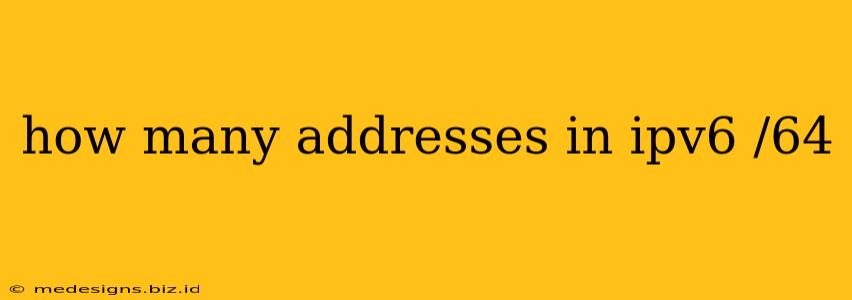How Many Addresses in an IPv6 /64 Network?
The question of how many addresses are in an IPv6 /64 network is a fundamental one for anyone working with IPv6 networking. Understanding this is crucial for network planning and resource allocation. The answer, however, is surprisingly straightforward, relying on the basics of IP addressing.
Understanding IPv6 Addressing
IPv6 uses 128-bit addresses, significantly larger than IPv4's 32-bit addresses. This vast address space allows for a truly enormous number of unique IP addresses. The /64 notation refers to the subnet mask, indicating the number of bits used for the network prefix. In this case, 64 bits define the network portion, leaving the remaining 64 bits for host addresses.
Calculating the Number of Addresses
To calculate the number of available addresses in an IPv6 /64 network, we simply calculate 2 raised to the power of the number of host bits. Since we have 64 bits for host addresses, the calculation is:
264
This results in a truly massive number:
18,446,744,073,709,551,616
This means a single IPv6 /64 network provides a staggering 18 quintillion addresses. This is more than enough to assign unique IP addresses to every single device on Earth, many times over, even considering the rapidly growing Internet of Things (IoT).
Implications of the Massive Address Space
The sheer number of available addresses in an IPv6 /64 network has several important implications:
- No More IP Address Shortage: The IPv6 address space effectively eliminates the IP address exhaustion problems that plagued IPv4.
- Simplified Network Management: The vast address space allows for simpler network designs and management, with less need for complex address allocation schemes.
- Enhanced Security: The abundant addresses contribute to enhanced security by enabling more granular control over network access and facilitating the use of unique addresses for individual devices.
Beyond the /64: Subnetting and Further Divisions
While a /64 provides an immense number of addresses, it's also possible to subnet an IPv6 /64 network into smaller subnets. This allows for greater control over network segmentation and resource allocation. However, even after subnetting, the number of available addresses in each subnet remains enormous compared to IPv4.
Conclusion
In conclusion, an IPv6 /64 network offers 18,446,744,073,709,551,616 addresses. This virtually limitless address space is a key advantage of IPv6, solving the long-standing problem of IP address scarcity and paving the way for a more connected and secure internet future. Understanding this fundamental aspect of IPv6 addressing is essential for anyone involved in network administration, design, or security.
